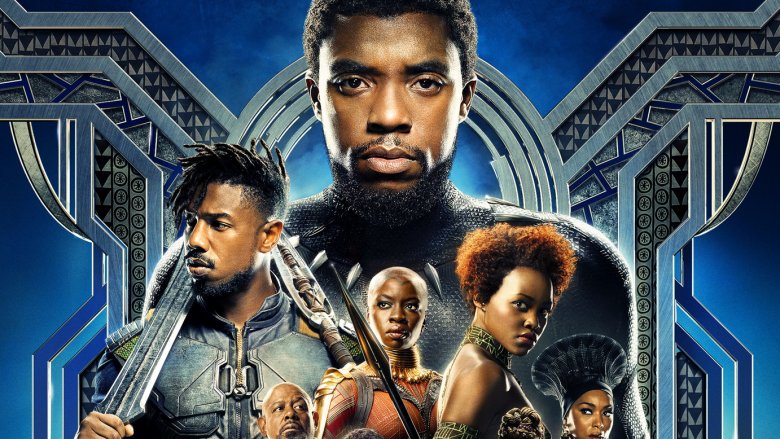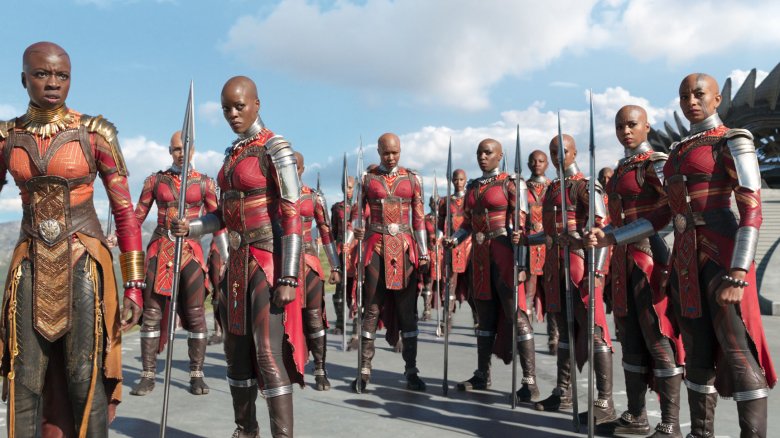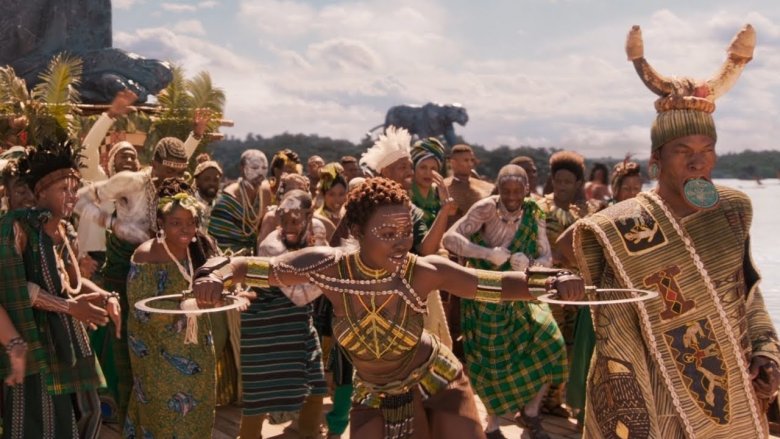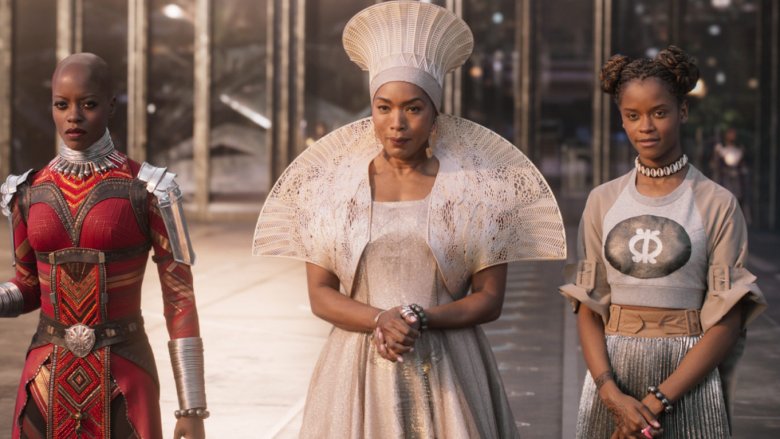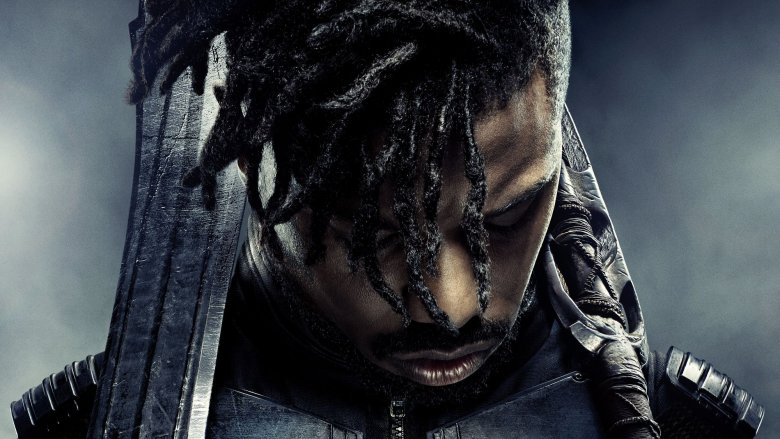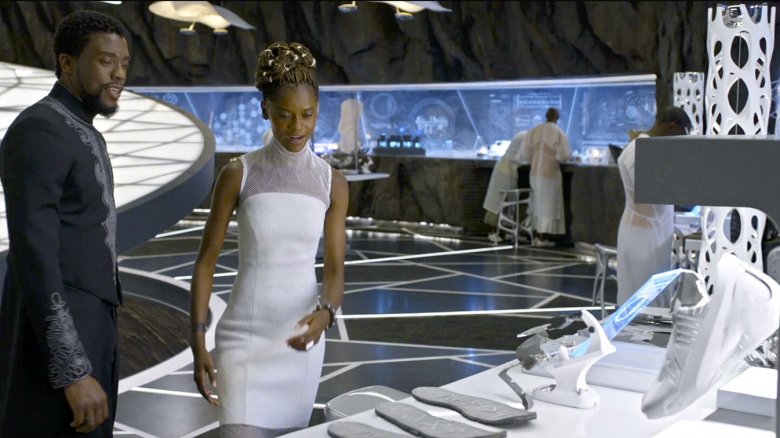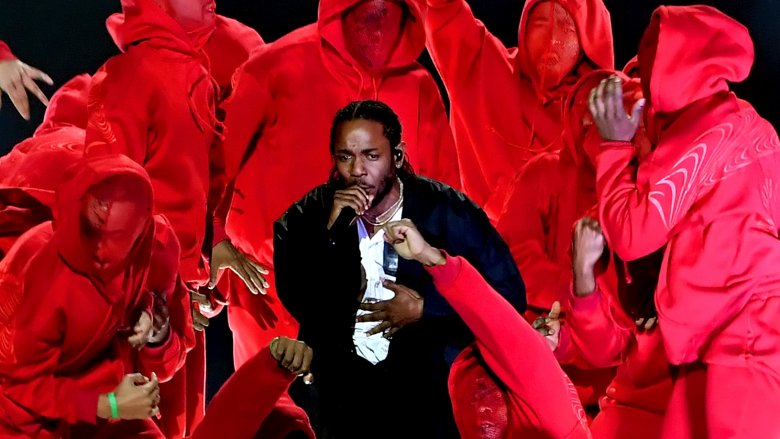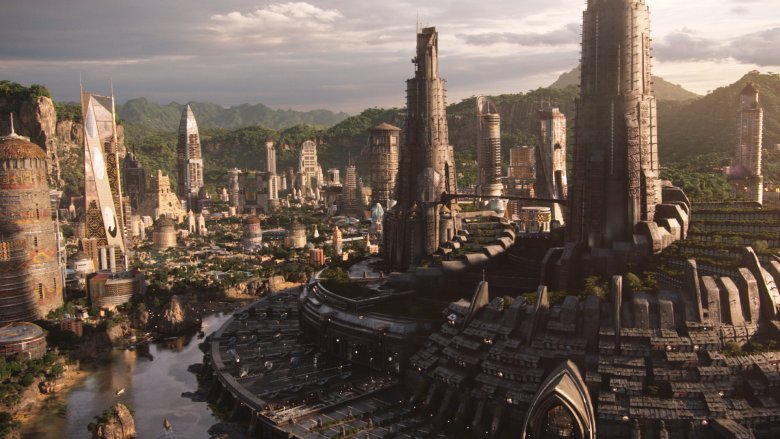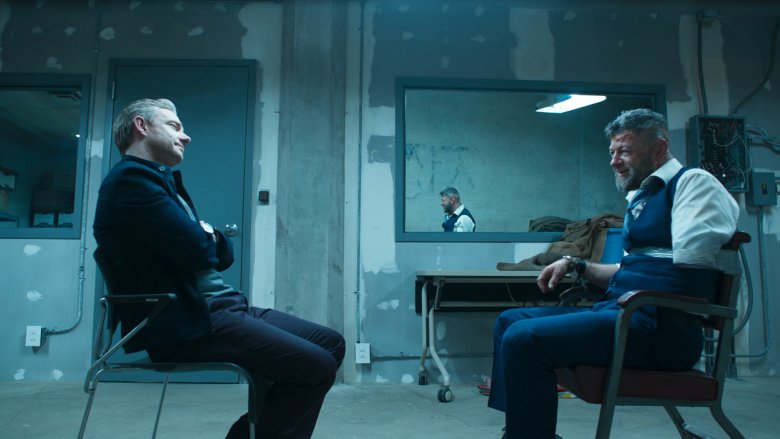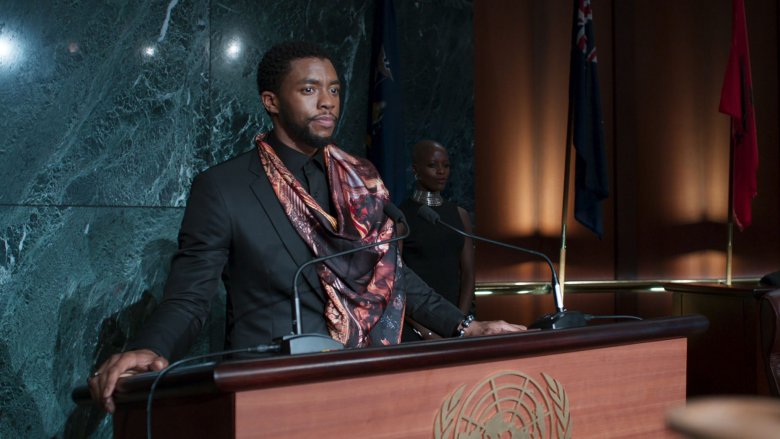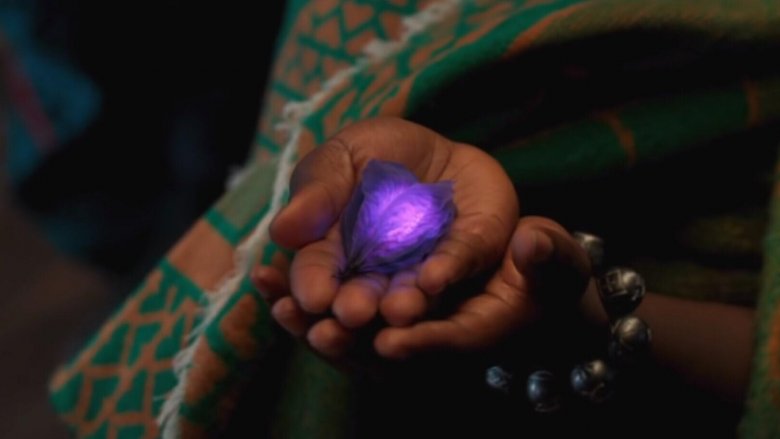How Black Panther Changed Superhero Movies And Nobody Noticed
There was a time before Black Panther, murky and distant as it seems now. Somehow, even without Killmonger, Kimoyo beads, and the heart-shaped herb, the Marvel Cinematic Universe films were lucrative, popular, and culture-defining. The Avengers from 2012 was a legit phenomenon, and the MCU's string of hits elevated previous obscure Marvel characters like Bucky Barnes and Black Widow into the mainstream. Then came Black Panther, and, for its most ardent fans, it split the MCU into two distinct halves: before T'Challa, and after. The film was so successful and societally significant that it almost seems hard to imagine that there was a Marvel universe without Wakanda.
But Black Panther's impact can't just be measured in dollars and accolades. A couple of years after its debut, superhero fans the world over are starting to realize that this movie might've changed the cinematic landscape forever. In ways large and small, we're seeing the ripples sent out from the chunk of Vibranium Ryan Coogler launched in the ocean that is the cape-and-cowl set — and they are, frankly, improving the genre by leaps and bounds.
Women aren't just the love interests
Think back to Phase One of the MCU. Remember the great jokes, the impressive costume design, the heartfelt expressions of heroism. Now try to remember every female character from those movies you can. It's mostly the girlfriends, right? Pepper Potts, Peggy Carter, Jane Foster, plus some side characters like the irrepressible Darcy, Sif, Frigga, and, ultimately, the introduction of Black Widow. It's not the direst situation to be found in Hollywood, but generally speaking if you're not there to smooch, you're either set dressing or the one very special lady Avenger who still spends a chunk of every movie playing the coquette to lure in her prey. Even Phase Two's introduction of Gamora in Guardians of the Galaxy fell into the same pattern, as she's relentlessly pursued by Peter Quill throughout the film.
Then came Black Panther in Phase Three and its cast full of women. There's Nakia, Shuri, Okoye and the Dora Milaje, Queen Ramonda, and women filling out the royal cabinet. Women were everywhere in Black Panther, doing everything. Both within the MCU and outside of it, this was pretty revolutionary. While Captain Marvel's starring role in 2019 was in development for years, Black Panther's amazing cast of women may have gotten audiences ready to receive the film a year earlier.
It proved that audiences will cheer on characters from cultures beyond their own
Blockbuster movies don't typically bet on the unfamiliar. Some of this is a matter of commerce trumping creativity, some of it is writers, producers, and directors mirroring what they know, and some of it is simple disinterest. A machinery of movie-making as vast, complex, and profitable as the MCU tends to feature familiar actors, locations, and themes. Few productions want to be the first to try something new, especially if they've got billions of dollars riding on their efforts. Fewer still make it all the way to a finished product.
Which makes Black Panther feel like kind of a miracle. It has a majority Black cast, takes place in a fictional African nation inspired by real African cultures, and features actors speaking Xhosa, an official language of Zimbabwe and South Africa. It is deeply rooted in specific places, histories, and aesthetics that most of the worldwide audience knows little about. And it made over $1 billion worldwide. Black Panther didn't just prove that people all over the world can embrace lives outside their own spheres of experience — it proved that they can fall in love with them, cheer them on, and come back for more.
It introduced new aesthetic influences
Superhero movies tend to look the same. Save for a signature color or a formalwear scene, it's all based in ultramodern tech and military drab. This can be an interesting look, of course, but it does tend to blend together into a canvas of olive green, stainless steel, and dark suits. Thor shook this up admirably, and, with the release of the positively psychedelic Thor: Ragnarok, cemented its branch of the MCU as a risk-taker. For a while, you had three choices: you could be surrounded by SHIELD black, army base grey, or you could be in Asgard.
The thing about all of these aesthetics, even Thor's, is that they're familiar. We know how action movies look, how Western, vaguely medieval-based fantasy looks, how military movies look. The MCU did them all well, but they'd been done before.
Then in strides Black Panther, with its wealth of color, texture, and fashion both ancient and contemporary. Audiences saw with the deep green of the River Tribe, the bright coral of the Dora Milaje, and Shuri's up-to-the-minute bomber jackets. Costume designer Ruth E. Carter, who won as Oscar for her work on Black Panther, managed to bring color, history, and an entirely unique aesthetic the majority of the audience was unfamiliar with. It's not just cohesive, it's not just new to the genre, it's not just rooted in an absolute avalanche of research — it's all of those things and more, packed into one movie.
The bad guy can win the moral argument
Killmonger was an unscrupulous villain, willing to sacrifice anyone and everything to get what he wanted. He had no issue choking old women, murdering sages, and ruthlessly executing his girlfriend to achieve his aims. "I trained, I lied, I killed just to get here ... all this death, just so I could kill you," he tells T'Challa as they face each other down. He knows exactly how cruel his actions are, and he accepts that as the price he must pay. When he finally dies, it's with the blood of hundreds on his hands.
But in the midst of his assault upon Wakanda, he manages to actually win the moral argument the entire movie hinges on. He's animated by a rage at Wakanda's inaction, and his anger is so potently acted and argued that T'Challa ends up in the afterlife, confronting his dead dad with the points his enemy has made. In the end, T'Challa defeats Killmonger — but he honors him with a last glimpse of the sunset, and a version of his ideas incorporated into his royal agenda. Black Panther dared to show that the bad guy can be unquestionably bad, yet still have a valid point to make. In the end, in that sense, no one exactly lost or won. In the context of superhero movies, that ambiguity is daring indeed.
It imagined tech as intimately human and a force for good
No one's really sure how to feel about technology in the MCU. It enables things like Tony Stark's suits, on the one hand — but it also results in Ultron's accidental creation. It transforms Steve Rogers from a sickly scarecrow into a defender of justice — and then it inevitably falls into the wrong hands. Alien tech isn't much safer, used as much for Star-Lord's jet-boots as to remove Captain Marvel's memories of earth. It's something to be approached warily, and, if intertwined with one's body like Tony's arc reactor, taken out as soon as possible.
Visions of the tech-infused future are considerably sunnier in Wakanda, however. Innovations like their Kimoyo beads are used to connect loved ones and neighbors, heal the sick, and, power the future of science. It's not that Vibranium is magically immune to ill intentions — rather, Wakanda places an emphasis on imagining technology as something that can be part of daily life, enhancing all that's already good and mending what's broken. The line between the artificial and the natural is blurred, in fact, most notably when a Kimoyo bead knits Everett Ross' spinal column back together. In Black Panther, technology isn't something scary, or a necessary evil. Instead, it's part of the world as a whole.
It brought the superheroic soundtrack into the spotlight
Historically, few people go to a superhero film for the soundtrack. Yes, we all remember John Williams' legendary Superman score. All right, we can hum the classic horn riff from The Avengers. But by and large, the music is an afterthought for most people who will see the movie. It's there to enhance what's on screen and maybe make you laugh with a clever needle drop or two. If you're lucky, you might get a pop tie-in that becomes a fascinating time capsule, a la Prince's "Batdance." But that's about as high as you can aim.
Black Panther, in contrast, ended up releasing its soundtrack to immense acclaim. Masterminded by Kendrick Lamar, songs like "All the Stars" and "King's Dead" became smash hits, the latter garnering a Grammy for Best Rap Performance. And suddenly, in the post-Black Panther world, superhero soundtracks featuring original music mattered in a way they hadn't in years. The music isn't subordinate to the story any longer — it can be the story in and of itself.
It rooted the action in a new and unique locale
Marvel's home base has always been New York City. This has done a lot to bring a unique sense of place to the stories that take place within it: Daredevil, She-Hulk, and Spider-Man are living in locations you can visit, that their creators grew up in, that mirror the rapid changes of 20th and 21st-century life with a specificity that's hard to replicate in Metropolis or Gotham. Peter Parker is a boy from Queens, just as Daredevil is a child of Hell's Kitchen. The city, to use a well-worn but very true cliche, is as much a Marvel character as Captain America.
But that can start to feel a bit confining, especially when the same city is splashed across the screen over and over again. Marvel branched out, for sure — Guardians of the Galaxy went far afield indeed — but there wasn't anywhere with the same strength of location until Wakanda came along. Rooted in painstaking research of actual African cities and cultures, Wakanda looks, sounds, and feels like a real place with real history. Audiences agreed, cheering when the heroes returned to Wakanda in Infinity War and spurring the creation of "citizen of Wakanda" merchandise by the truckload. Black Panther didn't just show that audiences can invest in MCU locations beyond NYC and outer space — they can fall in love with them.
It dared to make one of its villains silly — and still scary
Killmonger might overshadow everyone else by a Wakandan mile, but let us not forget Ulysses Klaue, the other villain in Black Panther. In his prior MCU appearance, he was a general brute, confronted by Scarlet Witch and Quicksilver in Age of Ultron as so many baddies are confronted by our heroes. He was grimy, he was sketchy, he was dealt with, temporarily. Andy Serkis did his best, but he was confined to a scant few minutes of screentime.
Enter a new director, cast, and team of writers. Suddenly, Klaue was stealing scenes as a terrifyingly overgrown bully eager to promote his Soundcloud mixtape. He gleefully screeches how "awesome" it is when Nakia, T'Challa, and Okoye battle them in a South Korean casino. He cracks bad jokes as he murders minions. He was scary, sure, but in his actions, not his demeanor. And he ended up more memorable than any other secondary villain of his stripe. Black Panther's whole-hearted embrace of Serkis' vivid performance proved that the bad guys can be interesting, even embarrassing, even outright cringe-worthy, and still be credible threats. In fact, they're nearly scarier when they're allowed to be anything other than "generically menacing" — they feel like someone you might know, with a link to terrible music in tow.
Superheroes can be diplomats, now
T'challa isn't the first royal in the MCU. Thor, of course, begins his journey as heir to the throne of Asgard, on a path to discovering what makes someone worthy of that authority. Loki has been twisted by his desire for kingly power into a perennial villain. Both, and the strand of the MCU tapestry confined to Asgard, find themselves often concerned with battle.
This isn't a flaw — these are, after all, action movies. But T'Challa's kingship is defined as much by his role in international diplomacy as his ability to send forces into battle. Much of Black Panther is concerned with how best to share Wakanda's resources with the rest of the world, how to aid in global conflicts responsibly, and, tellingly, how violence has typically led to tragic outcomes in Wakandan history. We don't see T'Challa commanding conquering armies — rather, we see him in discussion with his advisers, at the United Nations, and engaging in ceremonial combat as a means of peacefully transferring power. T'Challa is a diplomat first and a warrior second, a man who leads his troops into battle reluctantly. Superheroes, post-Black Panther, aren't confined to the Pentagon, military bases, or other martial visions of world power — they debate others, open community centers, and strive for global cooperation.
It made superpowers ancient and natural
Superpowers come from all kinds of places in the MCU: super-soldier serum concocted by military scientists, alien tech, old-fashioned human tech, interdimensional magic, a cosmic force tying the universe together...you get the idea. These power sources are usually either so outside the human sphere of knowledge as to be unintelligible or something we can very nearly picture existing in our real world, full of AI and genetic editing and body-based tech.
But now there's the heart-shaped herb. It's fictional, of course, but it looks a lot like something you might stumble across in your own garden. It's used in a recognizable way, crushed in a mortar and pestle the way spices and herbs have been ground for years. It grants T'challa powers that are, admittedly, incredible, but not as vast as those conferred upon the wielder of an Infinity Stone. It introduces an entirely new conception of superpowers into the MCU as ancient, intimately human, and eminently natural. This has vast worldbuilding possibilities: Have there always been superheroes in the MCU, in a sense? Are there other, similar herbs all over the world? Might we ever see the MCU travel further back in time than the 1940s? We don't know now, but we know enough to wonder.
